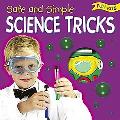

 |

|

The average rating for Safe and Simple Science Tricks based on 2 reviews is 3 stars.
Review # 1 was written on 2020-08-12 00:00:00 Michael Solof Michael SolofThe book discusses how the institutions of private, government, and academic science from 1846-1876 developed. The author chose to focus almost exclusively on the natural sciences and mathematics - a limitation acknowledged and discussed early in the book. Within those boundaries, however, the book explores broadly and provides an excellent bibliography for those looking for further reading in particular areas. While the writing does not aspire to be entertaining, the language is clear and easy to read, despite the occasional awkward humor or clumsy commentary on race and class divisions. What made this rather extensive book worth the time to read was the authors skill in conveying a sense-of-the-times with well chosen historical detail and a wide variety of primary sources. While I knew the broad outlines of American history during the years the book focuses on, reading this book has given me a vivid sense of the processes, constraints, and conflicts that occupied the lives of scientists and bureaucrats. While some of the ongoing scientific disputes of the day, especially those related to Darwinism, are discussed in some detail, the author is primarily interested in the organizations and institutions that turned science in the United States from the hobby of a few rich eccentrics into a central element of higher education, industrial development, and national funding priorities. In the beginning of this process of development, there were many competing models for how science would be organized. 'Democratic' ideals favored privately funded science organized around local societies, while Europe's success with the emerging University system provided an alternate model that was viewed with a mix of envy and suspicion. Since much of American science was focused on collecting examples of the geology, flora, and fauna of the new world, the military, and its expeditions, were an important resource for early naturalists. The majority of the book describes the resolution of the conflict between these different modes of organizing, and the personalities and institutions that advocated each of them. Recommended reading for those involved in the sciences or with an interest in 19th century America. For the more general reader, the book is valuable as a case study in competition between institions with similar missions but conflicting ideologies - in particular because the resolution of this conflict in America leads directly to todays system of professional science and engineering - a state of affairs that contrasts sharply with the 'democratic' and popular notions of scientific organization that existed in 1846. |
Review # 2 was written on 2019-05-04 00:00:00 Jesse Jorde Jesse JordeThis is an extraordinary book. Winner of the Pulitzer Prize, the book delves into the history of modern American science, focusing on the tremendous changes during the period preceding, through, and after the Civil War. The density of information of the book is astounding, which makes the book a long read but worth the effort. Recommended for scientists and Civil War era historians. |
CAN'T FIND WHAT YOU'RE LOOKING FOR? CLICK HERE!!!